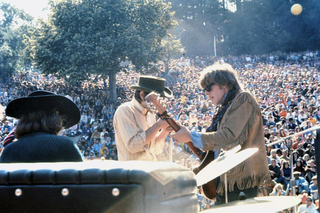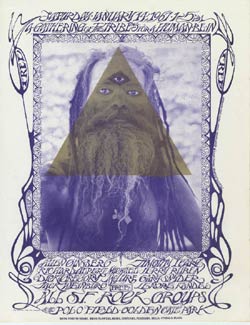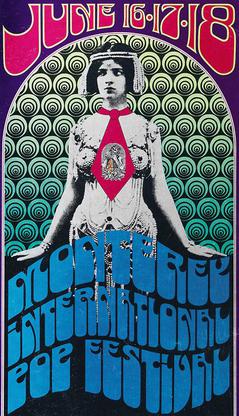
The Summer of Love was a social phenomenon that occurred during the summer of 1967, when as many as 100,000 people, mostly young people sporting hippie fashions of dress and behavior, converged in San Francisco's neighborhood of Haight-Ashbury. More broadly, the Summer of Love encompassed the hippie music, hallucinogenic drugs, anti-war, and free-love scene throughout the West Coast of the United States, and as far away as New York City.

A hippie, also spelled hippy, especially in British English, is someone associated with the counterculture of the 1960s, originally a youth movement that began in the United States during or around 1964 and spread to different countries around the world. The word hippie came from hipster and was used to describe beatniks who moved into New York City's Greenwich Village, in San Francisco's Haight-Ashbury district, and Chicago's Old Town community. The term hippie was used in print by San Francisco writer Michael Fallon, helping popularize use of the term in the media, although the tag was seen elsewhere earlier.

Mill Valley is a city in Marin County, California, United States, located about 14 miles (23 km) north of San Francisco via the Golden Gate Bridge and 52 miles (84 km) from Napa Valley. The population was 14,231 at the 2020 census.

The Human Be-In was an event held in San Francisco's Golden Gate Park Polo Fields on January 14, 1967. It was a prelude to San Francisco's Summer of Love, which made the Haight-Ashbury district a symbol of American counterculture and introduced the word "psychedelic" to suburbia.

The Monterey International Pop Festival was a three-day music festival held June 16 to 18, 1967, at the Monterey County Fairgrounds in Monterey, California. The festival is remembered for the first major American appearances by the Jimi Hendrix Experience, the Who and Ravi Shankar, the first large-scale public performance of Janis Joplin and the introduction of Otis Redding to a mass American audience.
Chester Leo "Chet" Helms, often called the father of San Francisco's 1967 "Summer of Love," was a music promoter and a counterculture figure in San Francisco during its hippie period in the mid- to-late 1960s.

Mount Tamalpais, known locally as Mount Tam, is a peak in Marin County, California, United States, often considered symbolic of Marin County. Much of Mount Tamalpais is protected within public lands such as Mount Tamalpais State Park, the Marin Municipal Water District watershed, and National Park Service land, such as Muir Woods.
Mount Rushmore was an American rock band in the late 1960s from San Francisco, California, United States, that played a heavy blues rock style with psychedelic elements. AllMusic described the outfit as "also-rans of the San Francisco psychedelic era". They were named after the colossal statue in South Dakota, Mount Rushmore.

The Sons of Champlin are an American rock band, from Marin County, California, in the San Francisco Bay Area, formed in 1965. They are fronted by vocalist-keyboardist-guitarist Bill Champlin, who later joined rock band Chicago, from 1981 to 2009, placing Sons of Champlin on hiatus from 1981 to 1996. They brought to the late ‘60s music scene in the Bay Area a soulful sound built around a horn section, sophisticated arrangements, philosophical themes, Bill Champlin's songwriting and blue-eyed soul singing, and Terry Haggerty's jazz-based guitar. They are one of the enduring 1960s San Francisco bands, along with Jefferson Airplane, the Grateful Dead and Moby Grape.

KFRC was a radio station in San Francisco, California, United States, which made its first broadcast on Wednesday, September 24, 1924, from studios in the Hotel Whitcomb, at 1231 Market Street. KFRC originally broadcast with 50 watts on the 270 meter wavelength, then moved to 660 kHz in April 1927. As part of nationwide frequency reallocations on November 11, 1928, KFRC was moved to 610 kHz, where the call letters remained until 2005.
The hippie subculture began its development as a youth movement in the United States during the early 1960s and then developed around the world.

Triangle is the fourth studio album by American rock band the Beau Brummels. Produced by Lenny Waronker and released in July 1967, it was the band's first album to include songs that vocalist Sal Valentino and guitarist Ron Elliott composed together. The band incorporated fantasy elements and surreal characters into the album's song titles and lyrics, and worked with a variety of session musicians to create Triangle's psychedelic musical style. The Beau Brummels were reduced to a trio—Valentino, Elliott, and Ron Meagher—at the time Triangle was recorded, as former group members Don Irving (guitars) and John Petersen (drums) left the band following the release of the group's previous album, Beau Brummels '66.

Blackburn & Snow were a folk rock duo popular early in the mid-1960s San Francisco music scene in the United States. The duo consisted of guitarist-singer Jeff Blackburn and vocalist Sherry Snow.

The Lamp of Childhood was a short-lived American folk rock band formed in Los Angeles, California in 1966. The band released three singles which failed to chart and disbanded in 1967, but had several notable members.
Salvation was a late-1960s American psychedelic rock band, formed in Seattle, Washington, and later based in San Francisco, California.
Tom Rounds was an American radio broadcasting executive, founder and chief executive officer of Radio Express in Burbank, California.

"Electricity" is a song by Captain Beefheart and his Magic Band on the 1967 album Safe as Milk. Beefheart claimed the label he and his band were signed to, A&M Records, dropped them after co-owner Jerry Moss heard the song and declared it "too negative" for his teenage daughter to listen to. Beefheart's vocals, while recording the final version for the album, shattered the microphone.

The Sidney B. Cushing Memorial Amphitheatre, also known as the Cushing Memorial Amphitheatre or simply the Mountain Theatre, is a 4,000-seat open-air venue in Mount Tamalpais State Park, in Marin County, California, United States.

The Miami Pop Festival was a rock festival that took place from December 28-30, 1968, at Gulfstream Park, a horse racing track in Hallandale, Florida, just north of Miami. It is sometimes confused with a separate event that took place seven months earlier, at the same venue, though the two events were unrelated. The earlier event was officially publicized on promotional materials and in radio ads as the "1968 Pop and Underground Festival," and "The 1968 Pop Festival," but later came to be referred to colloquially as the "Miami" Pop Festival, a practice which has led to confusion between the two events.

Michael Goldberg is an American novelist, journalist, animal rights activist, and pioneering digital music entrepreneur. He is known for his work (1983-1993) at Rolling Stone, where he was first a senior writer and later West Coast editor, and for envisioning and co-founding the first web music magazine, Addicted to Noise, in 1994, for which Newsweek included him in its 1995 "Net 50" list of "the 50 People Who Matter Most on the Internet". Between 2014 and the fall of 2016 he published the Freak Scene Dream trilogy of 1970s coming-of-age novels, and worked actively in animal rights causes. His nonfiction book, Wicked Game: The True Story of Guitarist James Calvin Wilsey, was published in June of 2022.


















